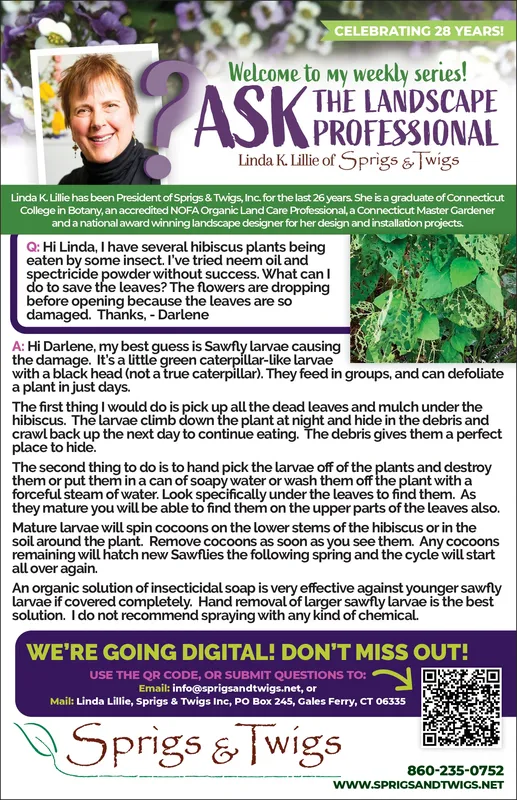Advertisement

-
Published Date
September 1, 2024This ad was originally published on this date and may contain an offer that is no longer valid. To learn more about this business and its most recent offers, click here.
Ad Text
CELEBRATING 28 YEARS! Welcome to My weekly series! THE LANDSCAPE ASK PROFESSIONAL Linda K. Lillie of Sprigs & Twigs Linda K. Lillie has been President of Sprigs & Twigs, Inc. for the last 26 years. She is a graduate of Connecticut College in Botany, an accredited NOFA Organic Land Care Professional, a Connecticut Master Gardener and a national award winning landscape designer for her design and installation projects. Q: Hi Linda, I have several hibiscus plants being eaten by some insect. I've tried neem oil and spectricide powder without success. What can I do to save the leaves? The flowers are dropping before opening because the leaves are so damaged. Thanks, - Darlene A: Hi Darlene, my best guess is Sawfly larvae causing the damage. It's a little green caterpillar-like larvae with a black head (not a true caterpillar). They feed in groups, and can defoliate a plant in just days. The first thing I would do is pick up all the dead leaves and mulch under the hibiscus. The larvae climb down the plant at night and hide in the debris and crawl back up the next day to continue eating. The debris gives them a perfect place to hide. The second thing to do is to hand pick the larvae off of the plants and destroy them or put them in a can of soapy water or wash them off the plant with a forceful steam of water. Look specifically under the leaves to find them. As they mature you will be able to find them on the upper parts of the leaves also. Mature larvae will spin cocoons on the lower stems of the hibiscus or in the soil around the plant. Remove cocoons as soon as you see them. Any cocoons remaining will hatch new Sawflies the following spring and the cycle will start all over again. An organic solution of insecticidal soap is very effective against younger sawfly larvae if covered completely. Hand removal of larger sawfly larvae is the best solution. I do not recommend spraying with any kind of chemical. WE'RE GOING DIGITAL! DON'T MISS OUT! USE THE QR CODE, OR SUBMIT QUESTIONS TO: Email: info@sprigsandtwigs.net, or Mail: Linda Lillie, Sprigs & Twigs Inc, PO Box 245, Gales Ferry, CT 06335 Sprigs & Twigs 860-235-0752 WWW.SPRIGSANDTWIGS.NET CELEBRATING 28 YEARS ! Welcome to My weekly series ! THE LANDSCAPE ASK PROFESSIONAL Linda K. Lillie of Sprigs & Twigs Linda K. Lillie has been President of Sprigs & Twigs , Inc. for the last 26 years . She is a graduate of Connecticut College in Botany , an accredited NOFA Organic Land Care Professional , a Connecticut Master Gardener and a national award winning landscape designer for her design and installation projects . Q : Hi Linda , I have several hibiscus plants being eaten by some insect . I've tried neem oil and spectricide powder without success . What can I do to save the leaves ? The flowers are dropping before opening because the leaves are so damaged . Thanks , - Darlene A : Hi Darlene , my best guess is Sawfly larvae causing the damage . It's a little green caterpillar - like larvae with a black head ( not a true caterpillar ) . They feed in groups , and can defoliate a plant in just days . The first thing I would do is pick up all the dead leaves and mulch under the hibiscus . The larvae climb down the plant at night and hide in the debris and crawl back up the next day to continue eating . The debris gives them a perfect place to hide . The second thing to do is to hand pick the larvae off of the plants and destroy them or put them in a can of soapy water or wash them off the plant with a forceful steam of water . Look specifically under the leaves to find them . As they mature you will be able to find them on the upper parts of the leaves also . Mature larvae will spin cocoons on the lower stems of the hibiscus or in the soil around the plant . Remove cocoons as soon as you see them . Any cocoons remaining will hatch new Sawflies the following spring and the cycle will start all over again . An organic solution of insecticidal soap is very effective against younger sawfly larvae if covered completely . Hand removal of larger sawfly larvae is the best solution . I do not recommend spraying with any kind of chemical . WE'RE GOING DIGITAL ! DON'T MISS OUT ! USE THE QR CODE , OR SUBMIT QUESTIONS TO : Email : info@sprigsandtwigs.net , or Mail : Linda Lillie , Sprigs & Twigs Inc , PO Box 245 , Gales Ferry , CT 06335 Sprigs & Twigs 860-235-0752 WWW.SPRIGSANDTWIGS.NET
